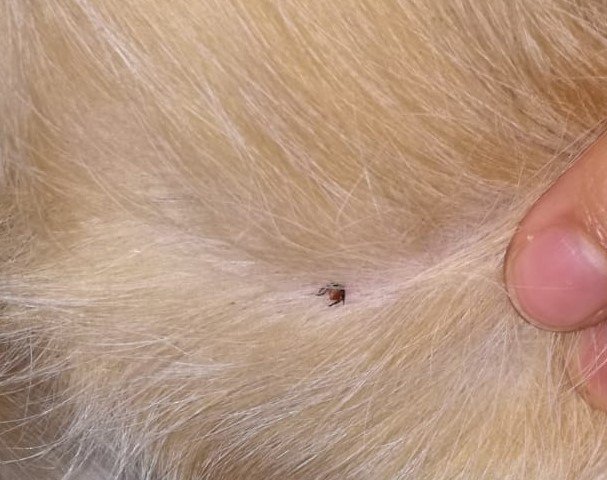This post contains affiliate links. If you click on a link and make a purchase I earn a commission at no extra cost for you.
As dog owners, we always have to remember that our four-legged friends are all too easily the victims of ticks. Ticks can transmit viruses and bacteria, which can lead to dangerous diseases that can make our pets extremely sick or even kill them. Treating tick-borne diseases is often complicated, expensive, and very stressful for our dogs. To repel ticks on dogs and thus prevent tick bites is much easier than to rid the dog of an acute tick infestation or even healing a sick dog.
Is it really necessary to repel ticks on dogs?
Ticks live almost everywhere where pet owners go for a walk with their dogs or where free-running dogs roam. Every time your pet is outside, it can pick one or more ticks.
Unlike as in a human victim, where ticks crawl around for a while in search of a suitable bite site, ticks bite dogs almost right away, as most places in the fur are suitable for a tick bite.
Although the tick itself and the bite are not dangerous for the dog, ticks harbor various pathogens that they can transmit to the dog through their bite. The disease ticks transmit can make your dog very sick or even be deadly for your pet. Prevention of tick-transmitted diseases is easier, cheaper, and not as stressful for your dog (and yourself) as treating a sick dog. Let’s look at the effective methods to repel ticks from dogs.
Synthetic Versus Natural Tick Repellent
There are synthetic tick repellents and natural tick repellents. They differ greatly in their effectiveness, each having its pros and cons. You need to consider which ones you use by weighing the possible side effects of each preparation against the benefits they offer.
How to repel Ticks on Dogs?
Spot-on preparations: Spot-on preparations contain substances that either prevent ticks from biting or kill ticks soon after they have bitten but before they can transmit pathogens. Spot-on preparations are applied externally in the neck of the dog, the active ingredients are absorbed and spread via the Sebaceous glands in the skin over the entire body of the dog.
Spot-on preparations act differently
- Contact antiparasitics – interfere with the metabolism of the parasite and kill it on contact.
- Repellents – keep parasites away by irritating the tick’s sensory organs and “camouflaging the host” and preventing infestation by the parasite (and thus the tick bite) from the outset; Repellents keep ticks away.
What repels ticks on dogs best?
There are many ways to protect yourself and your pet from ticks. In high-risk areas, where many ticks are found and the risk of a tick bite is high, the use of effective tick repellents is absolutely necessary.
Frontline Plus is effective in repelling ticks on dogs. Frontline can easily be applied once a month. Use the applicator, to apply directly onto the dog’s skin between the shoulder blades. The active ingredients in Frontline Plus will effectively kill ticks by disabling the insect’s neural system.
If you and your dog live in a city where there is not much green and no natural hiding places for ticks, then natural tick repellents together with regular grooming and bathing with tick-repelling dog shampoo may be enough to protect your dog from ticks.
- Provides fast-acting, long-lasting flea and tick protection for pets 8 weeks or older
- Kills adult fleas, ticks, chewing lice, mites, and flea eggs and larvae
- Waterproof 24 hours after application
- Easy to apply for once a month for lasting protection
- For best results, apply every month
Last update on 2025-07-12 / Affiliate links / Images from Amazon Product Advertising API
How to use external Tick repellents
Spot-on preparations
Work for about four weeks and must be reapplied after this time, but they are easy and convenient to use. When using spot-on preparations, make sure you apply them in a place that your pet can not lick, usually in the neck or between the shoulder blades. Part the fur and apply it directly to the skin of your pet.
If you have several animals make sure they don’t lick each other. Also, don’t let your dog swim or bathe for 2 days after application, as this will wash away the active ingredients of the preparations from the dog’s coat and skin and lose their effect.
Collars against ticks and fleas
To be effective, tick collars have to be snug around the dog’s neck, they are worn permanently in order for them to deliver their active agents directly to the dog’s coat for up to several months. The mode of action is similar to that of a spot-on. If your dog suffers any irritation, you have to consider using a different collar of a different brand.
Repellent sprays
Sprays are sprayed on the entire coat of the dog and usually have a similar mode of action and duration of action as spot-on preparations.
There are also sprays available that contain an ingredient called permethrin, they come as aerosols or pump spray bottles. Sprayed over the entire body of the pet they are used to eliminate an acute flea or tick infestation. Permethrin will remain in the coat for a couple of weeks effectively killing fleas and ticks on contact.
Tick repellent powders
The repellent powders are an effective method of killing ticks on dogs. They perform a dual role by killing the ticks already present, as well as, preventing them from further adherence. However, you have to ensure that you use a powder that is intended to be used for dogs and in the limited quantity mentioned.
Shampoos to repel ticks on dogs
Dog shampoos have proven beneficial to keep ticks and fleas away. But this provides only short-term protection and would need to be reapplied frequently. Dog shampoos are rather a means to reduce an acute tick or flea infestation.
Tick Dip
The tick dips can be made by purchasing a concentrated product and diluting them with water. They have to be applied to the entire body in a well-ventilated area. They have to be applied over the entire body of the pet.
Types of ticks on dogs

A dog can be affected by several ticks of different tick species. One of the most common tick species is the brown dog tick or the kennel tick. They are often found in dog kennels, animal pens, or even inside human homes. As much as they are a problem biting dogs and possibly transmitting disease, they rarely bite humans.
The deer tick is another common type of tick. They live in the woody areas and could infect dogs with Lyme disease.
Another dangerous type is the American dog tick, they prefers waiting for prey on grasslands and scrubs along trails. When fully engorged they can be the size of a grape. They are a common vector of Rocky Mountain spotted fever.
How to diagnose the tick infestation?
You have to regularly visibly check your dog’s coat for ticks. If any are found, they should be removed right away with appropriate methods. If left on your pet the risk of contracting a disease increases the longer they feed on your pet.
What happens when a tick bites?
The feeding process of a tick takes a few days of up to two weeks. During this time the ticks frequently regurgitate their stomach contents in the bite wound. This may transmit pathogens that cause diseases such as anaplasmosis, babesiosis, Lyme disease, ehrlichiosis, and others to the host. Left untreated some diseases can even be fatal.
So How to Repel ticks on dogs?
The best protection against tick-transmitted diseases would be to completely avoid ticks. This is near impossible as ticks are everywhere. You need to check your dog frequently for ticks and other parasites. More thorough when you have been to tick-prone territory. However, it is still easy to overlook a tick, especially small ticks that are still in the nymph stage. To protect your pet from blood-sucking pests and the diseases they transmit using spot-on preparations, sprays or antiparasitic collars is part of being a good responsible dog owner.




